Integrating fish growth with financial analysis can help farmers optimize operations
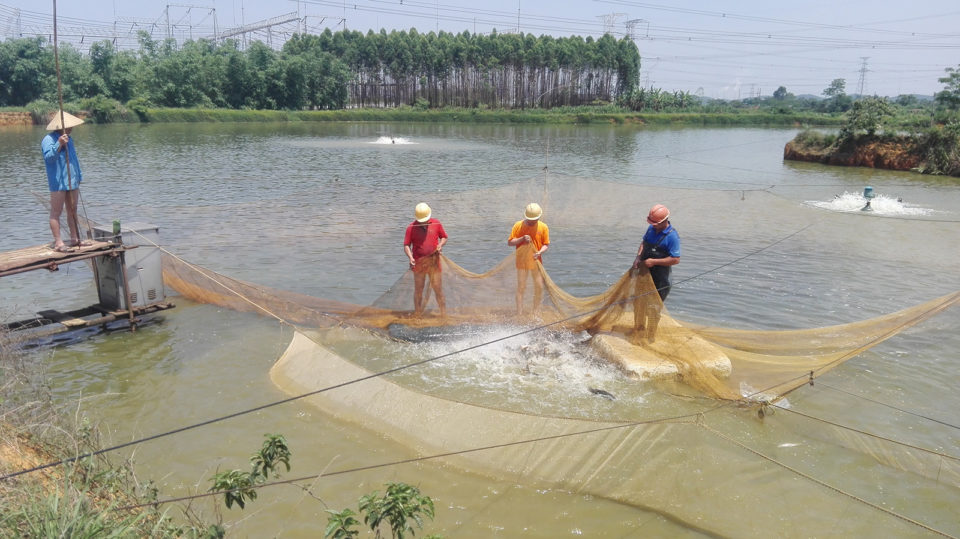
The Food and Agriculture Organization of the United Nations (FAO) has been devoted to helping farmers worldwide to improve the performance of their aquaculture operations. As part of this effort, a bio-economic model of tilapia pond culture has been developed based on experiences in China, the largest tilapia farming country accounting for more than 30 percent of the nearly 6 million metric tons (MT) of global tilapia aquaculture production in 2015.
Information and insights provided by the model indicate that bio-economic modeling can be a knowledge-based, climate-smart innovation for improving the performance of aquaculture. With the aim of attracting more attention and participation to bio-economic modeling, this article explains the key features of the model, highlights some insights revealed by it and discusses the way forward.
Detailed discussion on the methodology and results of the bio-economic model can be found in the Fisheries and Aquaculture Technical Paper No. 608 (Cai, J.N., Leung, P.S., Luo, Y.J., Yuan, X.H. & Yuan, Y.M. 2018. Improving the performance of tilapia farming under climate variation: perspective from bio-economic modeling. Rome, FAO).
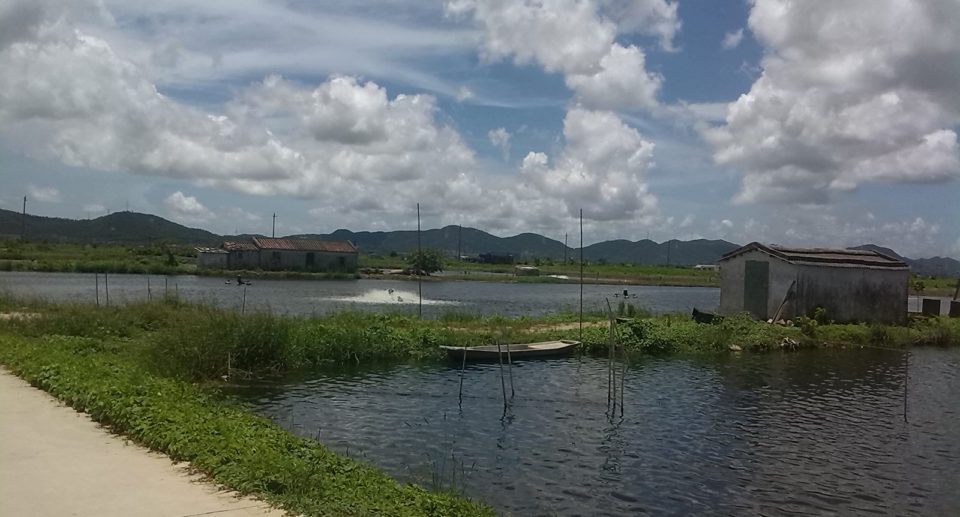
Why bio-economic modeling?
Like most agricultural activities, aquaculture is a complicated business that entails careful planning to balance the influence of many factors. Fish farmers usually plan their operations based on common practices, own experiences or expert advice. While farmers continually accumulate experiences in good farming practices and arrangements through trial and error, learning by practicing and knowledge-sharing among peers, experience-based business and operational planning tends to be inaccurate and less flexible in adapting to changes in environmental, technical or economic conditions.
Investment/financial models, such as the User-Friendly Tool For Investment Decision Making in Aquaculture (UTIDA) developed by FAO, have been used to help farmers or other practitioners to assess the performance of aquaculture operations for investment decisions or loan applications. While these models are also used to facilitate business planning, they are less capable in advising on optimal farming arrangements, such as when to stock the fish, how many fish to stock, when to harvest the fish, etc. Indeed, these models usually require users to first specify the farming arrangement of an operation (e.g. fingerling size, stocking density and growing period) as well as its outcomes (e.g. harvest size and the overall FCR) and then input the technical specification into the models to assess the financial performance (profitability, solvency and liquidity) of the operation.
Bio-economic modeling, which integrates detailed modeling of fish growth with financial analysis, can help farmers optimize their farming and business arrangements under ever changing climate, technical and market conditions. It represents a knowledge-based innovation that can improve the technical and financial performance of aquaculture under given farming conditions.
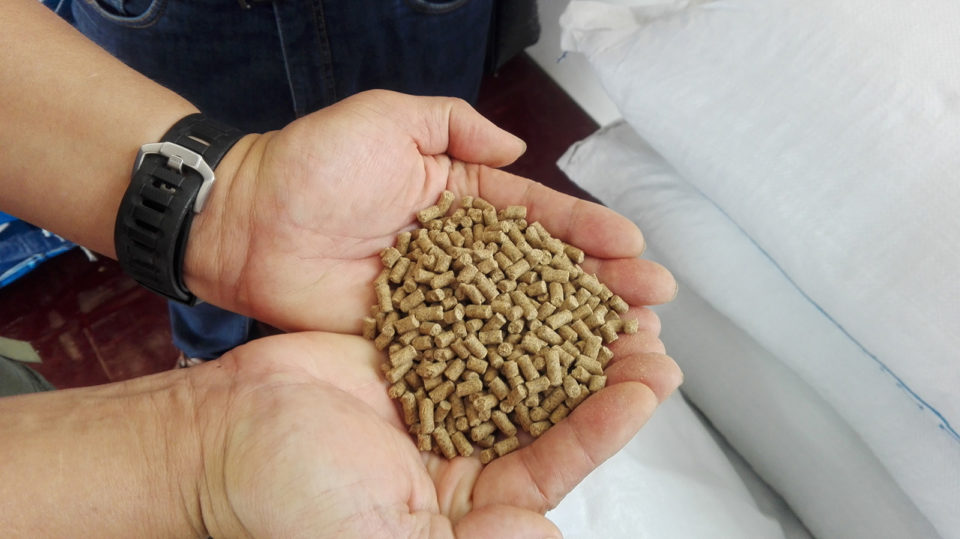
Key features of the bio-economic model of tilapia pond culture
The bio-economic model of tilapia pond culture in Cai et al. (2018) simulates tilapia growth under a certain feeding regime. In the model, a farmer is required to feed the fish according to a feeding schedule recommended in a technical guidebook on tilapia farming in China. The feeding schedule specifies daily feed rations according to fish body weights and the water temperatures. Based on the feed rations as well as the size of fish and the fish biomass in the pond, daily fish growth is estimated by the model, and the estimation accounts for the impacts of the water temperature and stocking density on fish growth.
In the model, a farmer is required to adopt good aquaculture practices, including (1) using good quality fingerlings and good quality feed with appropriate crude protein contents for fish at different growing stages, (2) following proper water quality management protocols such as the use of biological or chemical products for water treatment and installation and proper use of aeration facilities and (3) harvesting the fish before the fish biomass in the pond reaches a certain carry-capacity threshold.

Under these preset technical requirements, a farming arrangement is to decide four technical parameters: stocking timing, fingerling size, stocking density and growing period. Stocking timing matters because the bio-economic model accounts for seasonal variation in the water temperature. Crops starting at different stocking timings are subject to different water temperatures hence have different fish growth patterns.
Different combinations of the four technical parameters would result in a number of farming arrangements. Fish growth under these arrangements can be simulated and the resulting technical and economic performance evaluated in the model, and the arrangements that give the best performance can be identified by comparison.
Higher productivity ≠ higher profitability
Many simulation results of the bio-economic model indicate that farming arrangements that increase productivity (measured by kg/ha/week) may not always improve profitability (measured by CNY/ha/week; 1 Chinese Yuan, CNY = 0.16 US dollar). While this may not be a novel insight for some experts, it is often under-appreciated by farmers as well as researchers in their constant pursuit of higher yields without adequate attention to profitability.
The bio-economic model provides a conceptual framework and examples to help people understand why profitability and productivity may not go hand in hand. Intuitively, profitability is determined by productivity as well as profit margin which is equal to the fish sale price minus the cost per unit of production (aka break-even price). An increase in productivity can be accompanied by a decrease in profit margin, especially when the fish are getting bigger with lower feed efficiency. When the impact of increase in productivity is prevailed by decrease in profit margin, profitability would decline notwithstanding the productivity hike.

Profit maximization for individual crops ≠ overall profit maximization
Many bio-economic models in the literature (see citations in Cai et al. 2018, pp. 1-2) focus on identifying optimal stocking density or growing period (also called harvest time) under a farming environment with stable water temperatures. However, pond culture in reality is usually subject to different water temperatures during a year. With the impact of seasonal water temperature variation accounted for, the simulation results of the bio-economic model indicates that a farming arrangement that gives a high profitability in an individual crop may not result in a high overall profitability in a multi-crop operation.
As indicated in Fig. 1, the arrangement of a one-year, two-crop operation (given 1-gram fingerlings) starting at the best initial stocking timing (9 April, represented by orange dotted lines) would be nearly 20 percent more profitable than the arrangement starting on the least profitable initial stocking timing (18 June, represented by blue dotted lines. There is a two-week break for pond preparation between the harvest date and the stocking date for the next crop.).
However, the least profitable arrangement includes a highly profitable first crop (2,268 CNY/ha/week) and a second crop with much lower profitability (941 CNY), whereas the profitability of the two crops under the most profitable arrangement is more balanced (1,552 CNY/ha/week and 1 973 CNY/ha/week, respectively).
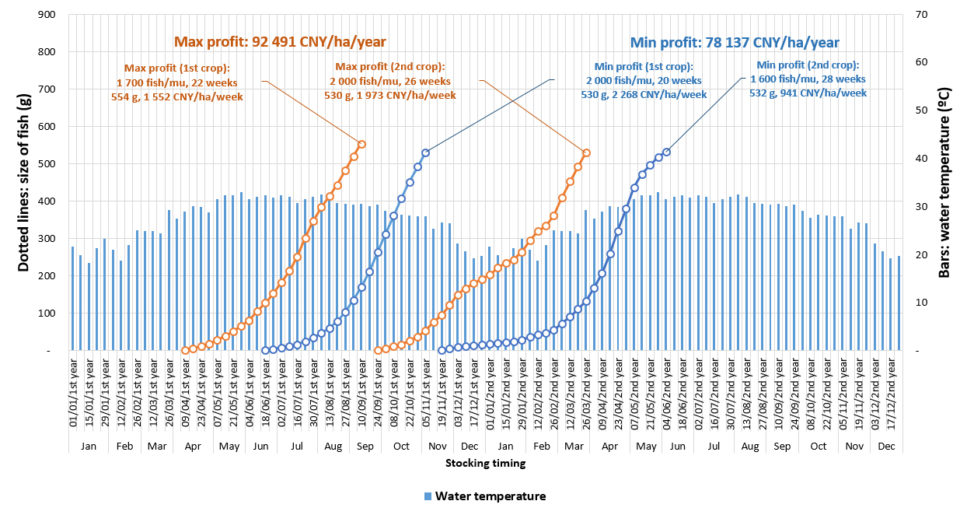
Indeed, an intriguing result is that a one-year, two-crop arrangement where the profit is maximized in both crops given their respective stocking timings may nevertheless not maximize the overall profitability. We encountered such cases when testing a stepwise strategy, under which a farmer would first determine the profit maximizing arrangement for the first crop, then determine the one for the second crop, the third crop and so on. We found that under the stepwise strategy, the farming arrangement could eventually converge to a one-year, two-crop arrangement with profit maximization in both crops. To our surprise, we found that the arrangement would nevertheless not maximize the overall profitability.
Intuitively, as the harvest timing of a crop affects the stocking timing of the next one, the arrangement of an individual crop would affect not only its own performance but also that of the next crop. When the arrangement that maximizes the profitability of the first crop results in a less opportune stocking timing for the second crop, even with the maximum profitability achieved in both crops, the overall profitability could be suboptimal. In other words, with path dependency, the stepwise strategy that maximizes the profitability of individual crops separately is not necessarily a strategy that maximizes the overall profitability; farmers should take a holistic approach to maximize the overall profitability of multiple crops.
Harvesting small-size tilapia
Some experts suggested that farming small-size tilapia could be more profitable (see, for example, the article “Could aquaculture solve Africa’s fishing crisis?” published by The Guardian on 5 June 2013). We used the bio-economic model to examine this conjecture. The simulation results indicate that given the low price for small-size tilapia (< 500 grams) in the Chinese market, harvesting small-size tilapia would not be more profitable. However, if without the price discrepancy, harvesting small-size tilapia (average 250 to 300 grams) in two-year, five-crop arrangements would tend to be more productive and profitable than one-year, two-crop arrangements that harvest > 500-gram fish (Fig. 2).
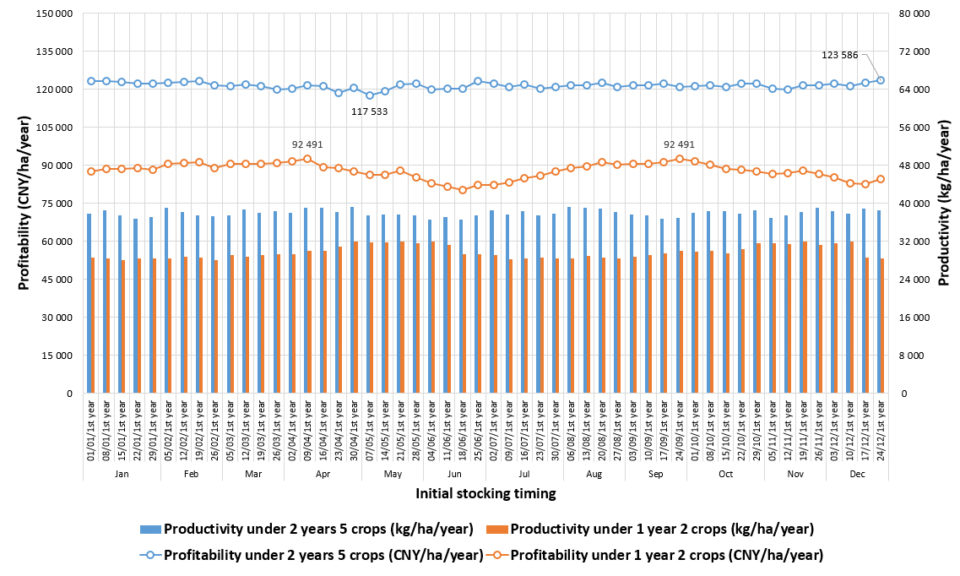
The simulation results indicate that none of the smaller harvest size, more crops or higher productivity is a sufficient condition for higher profitability. Thus, it is important to understand why harvesting small-size fish could increase the profitability. Farming relatively small-size fish can have a positive impact on profitability by allowing a higher stocking density (hence utilizing the pond area more efficiently). As mentioned above, the bio-economic model sets a carrying capacity threshold for total fish biomass in the pond, which would limit the stocking density according to the targeted harvest size.
Thus, a lower harvest size would allow a higher stocking density, which would increase the efficiency in pond utilization by increasing the fish biomass in the pond at the early stage when fish are small and lowering the FCR. However, farming small-size fish tends to be inefficient in the use of fingerlings and may miss the fast-growing part of tilapia growth. For example, in the baseline tilapia growth pattern used to calibrate the bio-economic model, it takes 14 weeks for the fish to grow from 1 gram to 250 grams, whereas it takes only an additional four weeks to grow over 500 grams. Harvesting small-size tilapia would improve profitability only when the positive impact outweighs the negative impact.
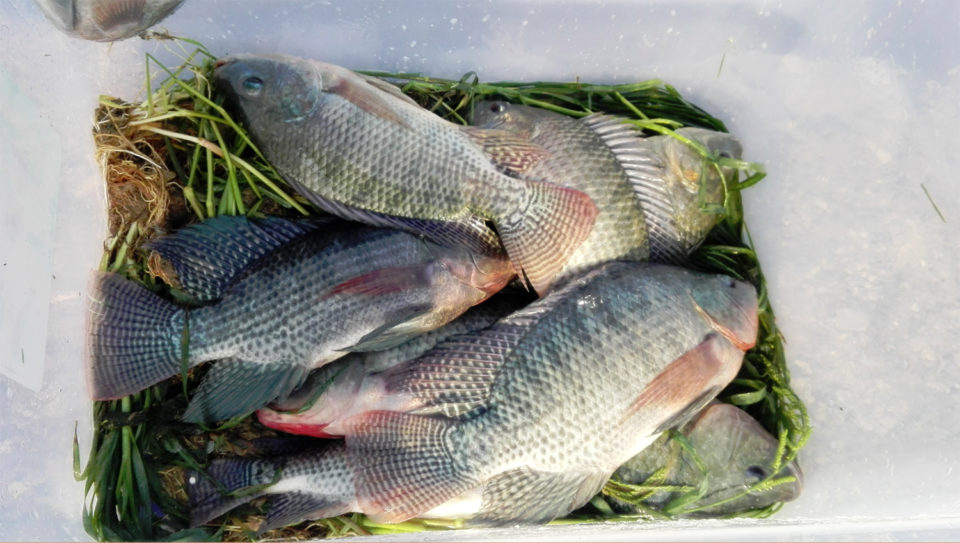
Multi-tier farming system
As discussed above, targeting smaller harvest size can increase the efficiency of pond utilization yet may miss the fasting growing part of tilapia growth. A multi-tier farming system could help farmer enjoy the benefit of the former without the cost of the latter. In a nutshell, a multi-tier farming system is to adjust the stocking density according to fish size so as to maintain the fish biomass in the pond at high levels. Such multi-tier systems have become increasingly popular. Tilapia farmers in Hainan province (China) often use a two-tier farming system to separate the nursing stage and outgrowing stage; some farmers even add an additional tier for growing fry to fingerlings – see more technical details in Cai et al. (2018, p. 53).
The bio-economic model has been used to simulate the farming arrangements of separating the nursing stage (growing 1-gram fingerlings to large-size fingerlings: 50 g, 100 g or 150 g) and the out-growing stage, and evaluate the technical and economic performance of the two-tier system. The results indicate that with the possibility of using large-size fingerlings farmed more efficiently under higher stocking density, the two-tier system could allow one-year, three-crop arrangements that increase the profitability by 60 to 90 percent (depending on initial stocking timings) compared to standard one-year, two-crop arrangements that use only 1-gram fingerlings.
Cai, bio-economic modeling,
| Indicators | First crop | Second crop | Third crop | Average |
|---|---|---|---|---|
| Stocking date | 30 April | 15 October | 22 January | – |
| Harvest date | 1 October | 8 January | 16 April | – |
| Fingerling size (g) | 1 | 100 | 150 | 82.6 |
| Stocking density (fish/mu) | 2,100 | 2,100 | 2,000 | 2,067 |
| Growing period (weeks) | 22 | 12 | 12 | 15.3 |
| Harvest size (g) | 504 | 506 | 523 | 511 |
| Productivity (kg/ha/week) | 662 | 1,137 | 1,121 | 914 |
| Productivity (kg/ha/year) | – | – | – | 47,507 |
| Profitability (CNY/ha/week) | 1,645 | 4,535 | 3,628 | 2,958 |
| Profitability (CNY/ha/year) | – | – | – | 153,082 |
The results also indicate that there is no single, most suitable fingerling size; most of the optimal one-year, three-crop arrangements for the 52 (weekly) initial stocking timings entail the use of different fingerling sizes for different crops – see an example in Table 1 which presents the one-year, three-crop arrangement that would generate the highest overall profit.
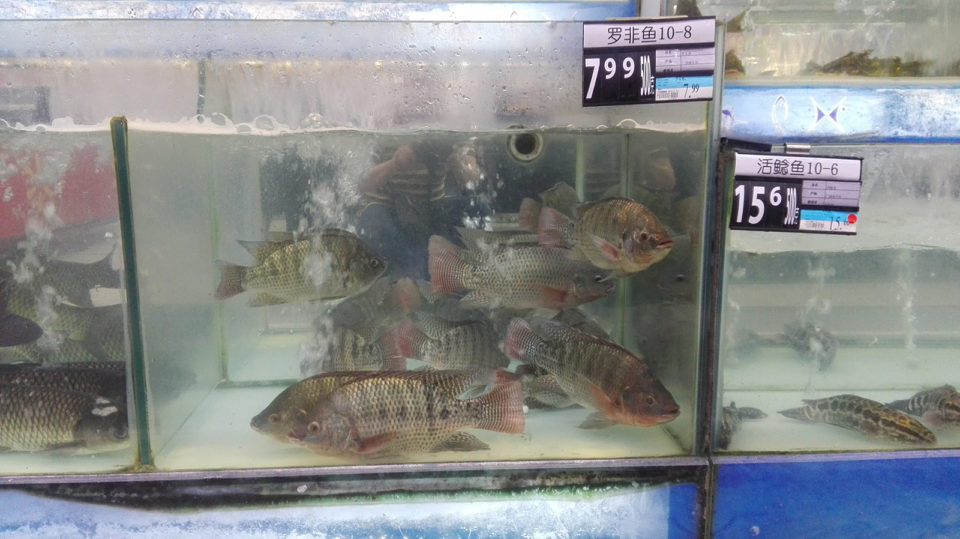
Way forward
Our bio-economic modeling endeavor started from the attempt to develop a simple model for identifying optimal harvesting strategies and ended with a bio-economic model that captures the impact of seasonal water temperature variation on fish growth and allows farmers to optimizing farming arrangement by selecting four technical parameters (stocking timing, fingerling size, stocking density and growing period). But this is only a baby step towards the ultimate goal of using bio-economic modeling to facilitate fish farmers’ business and operation planning in practice.
Being a sophisticated model notwithstanding, the bio-economic model has much room to improve. The biological part of the model can be strengthened by more rigorous modeling of fish growth based on more detailed, comprehensive data on tilapia growth under different conditions (water temperature, stocking density, feeding regimes, etc.) and accounting for more environmental factors (water supply, climate changes, etc.), while the economic part can be enhanced by accounting for the seasonality of the availability and prices of seed, feed and other inputs as well as fish price and introducing uncertainties to facilitate risk analysis.
Last but perhaps most importantly, a bio-economic model needs to be tailor-made according to local farming conditions and practices in order to become a practical tool for optimizing farming arrangements. Achieving this ultimate goal entails long-term, collective efforts of farmers, researchers, extension personnel and policymakers. Yet the benefit would certainly be worthwhile.
Now that you've reached the end of the article ...
… please consider supporting GSA’s mission to advance responsible seafood practices through education, advocacy and third-party assurances. The Advocate aims to document the evolution of responsible seafood practices and share the expansive knowledge of our vast network of contributors.
By becoming a Global Seafood Alliance member, you’re ensuring that all of the pre-competitive work we do through member benefits, resources and events can continue. Individual membership costs just $50 a year.
Not a GSA member? Join us.
Authors
-
Junning Cai, Ph.D.
Aquaculture Officer
FAO Fisheries and Aquaculture Department
Rome, Italy[103,114,111,46,111,97,102,64,105,97,67,46,103,110,105,110,110,117,74]
-
PingSun Leung, Ph.D.
Professor
University of Hawai‘i at Manoa
Honolulu, HI USA
Related Posts
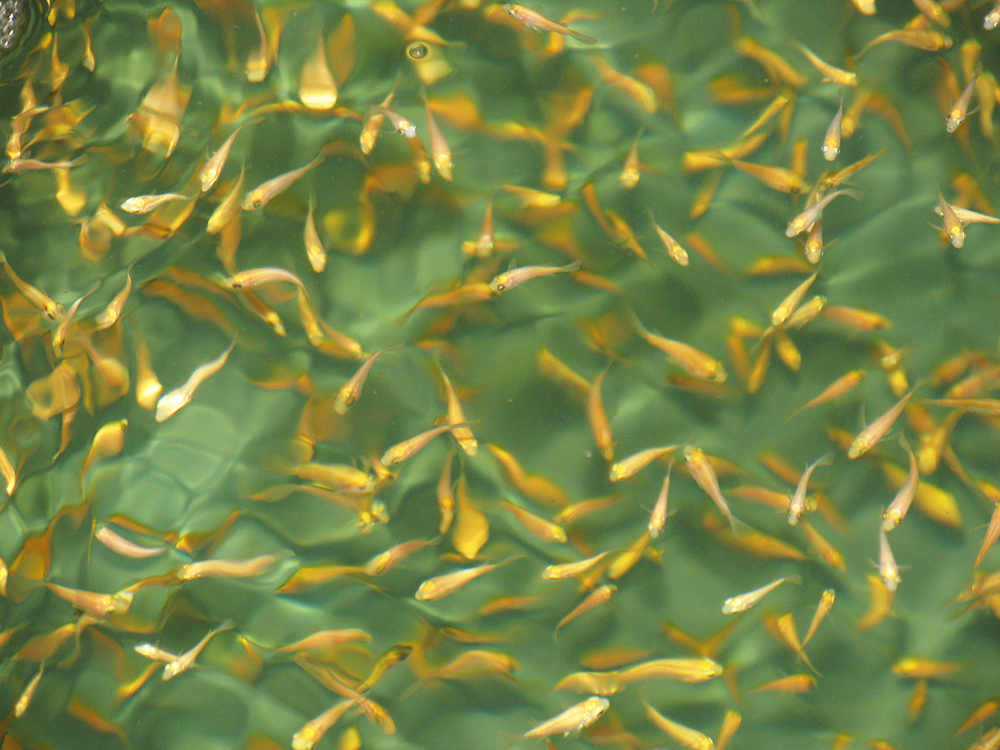
Health & Welfare
Biosecurity practices on fish farms need beefing up
Biosecurity measures and preventive strategies are essential in any biological production chain. Properly planned and implemented biosecurity programs will enhance animal health, production and economics.
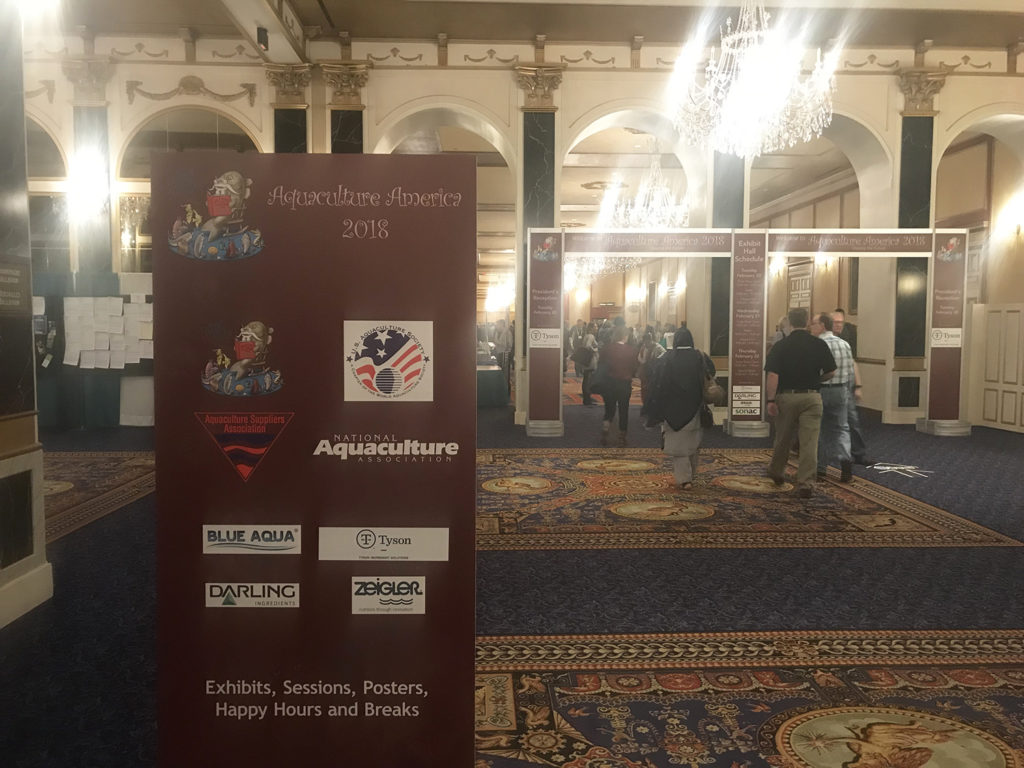
Innovation & Investment
At Aquaculture America 2018, signs of support for thriving domestic industry
Aquaculture must reshape its public narrative in order for the blue revolution to transpire. That’s what many prominent voices were saying at the World Aquaculture Society’s annual U.S. conference in Las Vegas.
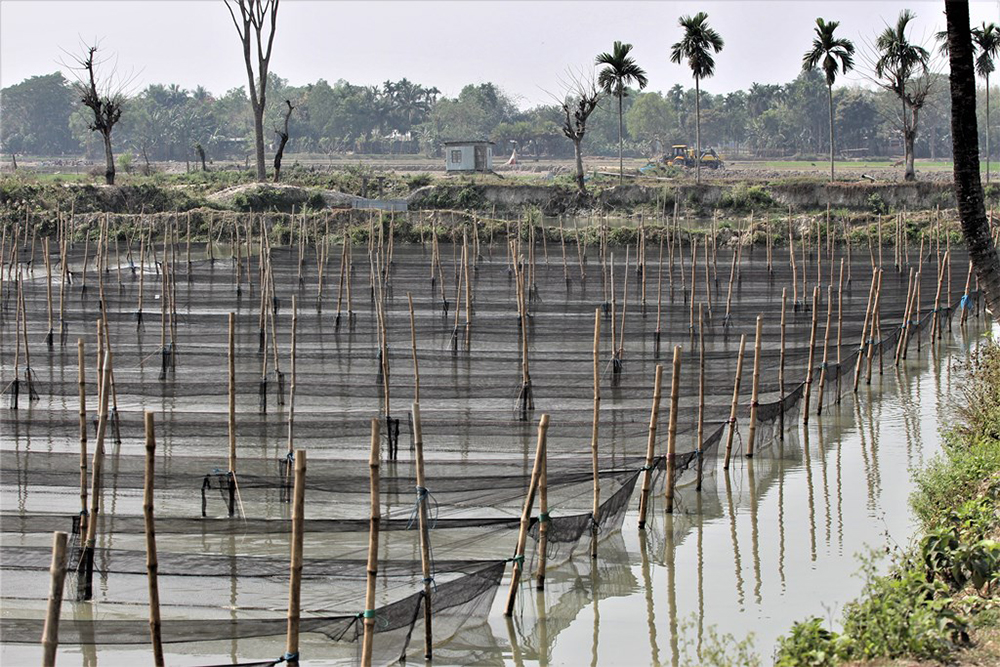
Intelligence
Bangladesh’s tilapia aquaculture industry shows resilience
Tilapia aquaculture in Bangladesh has developed significantly since 1999, based on the Genetically Improved Farmed Tilapia (GIFT) strain of Nile tilapia (Oreochromis niloticus) introduced from Malaysia and on the significant genetic improvement research work by the Bangladesh Fisheries Research Institute (BFRI).
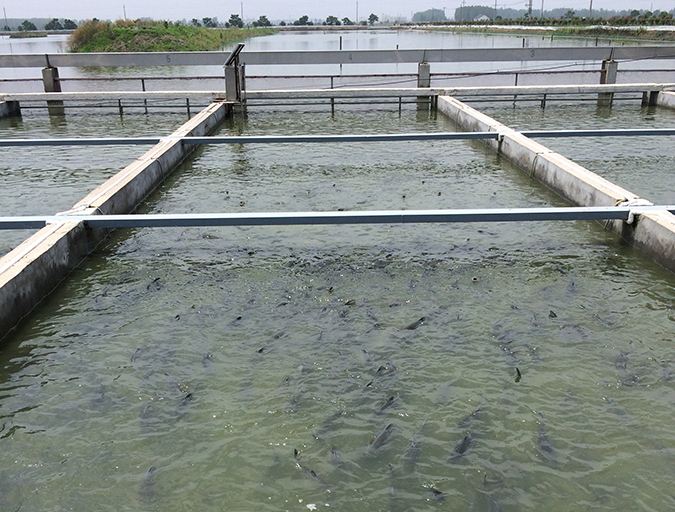
Innovation & Investment
GOAL 2016 preview: IPA technology catching on in China
Intensive pond aquaculture (IPA) technology, a floating, in-pond raceway system developed in the United States, is being adopted fast in China, just three years after its introduction, says Jim Zhang, aquaculture program manager for USSEC-China.



